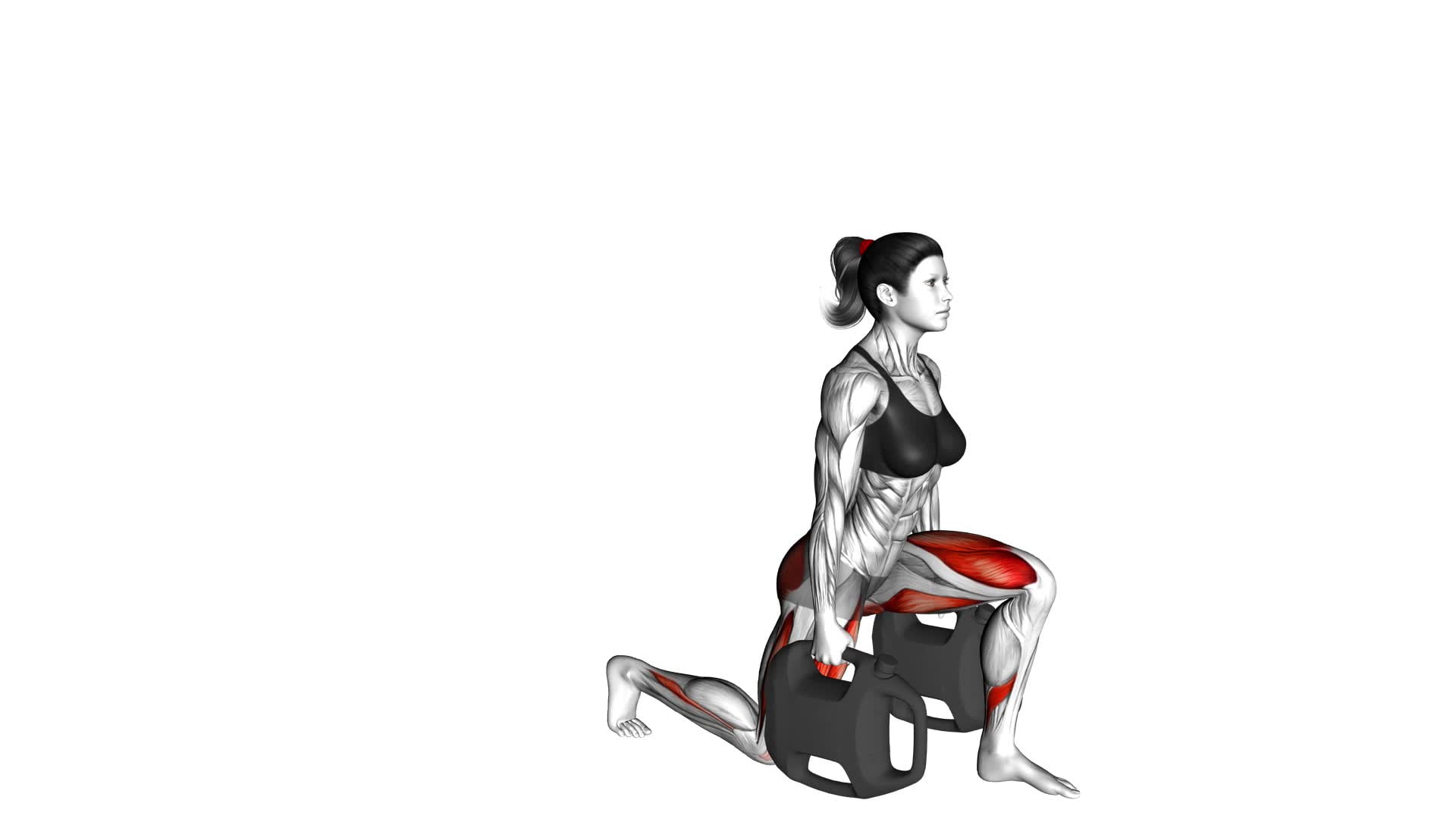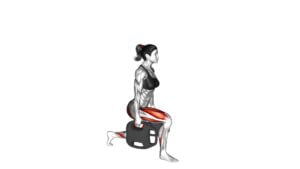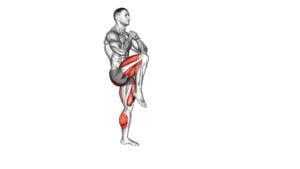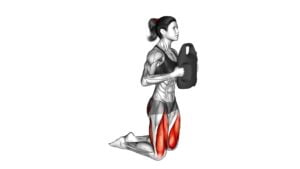Bottle Weighted Forward Lunge (female) – Video Exercise Guide & Tips

Are you looking to level up your lunges? Get ready to feel the burn with the bottle weighted forward lunge.
Watch This Exercise Video
This exercise targets your lower body and can be done at home with just a water bottle. In this guide, we'll show you the proper form and technique, modifications for different fitness levels, common mistakes to avoid, and tips for maximizing your results.
Let's get started and take your lunges to the next level!
Key Takeaways
- Targets lower body muscles such as quadriceps, hamstrings, and glutes
- Engages multiple muscle groups simultaneously
- Improves balance and stability
- Can be modified to suit different fitness levels and goals
Benefits of the Bottle Weighted Forward Lunge
The bottle weighted forward lunge offers a variety of benefits for women looking to strengthen their lower body muscles. This exercise specifically targets the muscles in the legs, including the quadriceps, hamstrings, and glutes. By incorporating the use of a bottle as added weight, you can increase the intensity of the exercise and promote greater muscular strength.
As you perform the bottle weighted forward lunge, you engage multiple muscle groups simultaneously, resulting in a more efficient and effective workout. The increased resistance provided by the bottle forces your muscles to work harder, leading to greater strength gains over time.
Additionally, this exercise helps to improve balance and stability. As you lunge forward and shift your weight, you challenge your body's ability to maintain proper alignment and control. This, in turn, strengthens the stabilizer muscles in your legs and core, which are essential for balance and stability in everyday activities.
Incorporating the bottle weighted forward lunge into your workout routine can help you achieve increased muscular strength and improved balance and stability. It's a versatile exercise that can be modified to suit your fitness level and goals. Remember to start with lighter weights and gradually increase as you become more comfortable and confident in your form and technique.
Proper Form and Technique
To perform the bottle weighted forward lunge with proper form and technique, follow these steps.
First, stand with your feet shoulder-width apart and hold a bottle in each hand, with your arms extended at your sides. Take a controlled step forward with your right leg, ensuring that your knee stays directly above your ankle.
As you lower your body, bend both knees to a 90-degree angle, keeping your back straight and your core engaged. Push off with your right foot and return to the starting position. Repeat the movement with your left leg.
Maintaining proper form and technique during the bottle weighted forward lunge is crucial for maximizing its benefits. This exercise not only targets specific muscle groups, such as the quadriceps, hamstrings, and glutes, but it also helps to improve balance.
By focusing on proper alignment and stability throughout the movement, you can enhance your body's coordination and proprioception. Remember to keep your chest lifted, shoulders relaxed, and gaze forward as you perform the lunge.
Avoid leaning too far forward or allowing your knees to extend past your toes, as this can put unnecessary strain on your joints. It's also essential to maintain a controlled pace and avoid rushing through the exercise.
Modifications for Different Fitness Levels
Customize the bottle weighted forward lunge to your fitness level by adjusting the weight of the bottles or modifying the depth of the lunge.
When it comes to the weight of the bottles, choose a weight that challenges you but still allows you to maintain proper form throughout the exercise. If you're a beginner, start with lighter bottles and gradually increase the weight as you become more comfortable and stronger. On the other hand, if you're more advanced, you can use heavier bottles to make the exercise more challenging.
In terms of modifying the depth of the lunge, you can start with a smaller range of motion if you're a beginner or have any mobility limitations. As you become more proficient, gradually increase the depth of your lunge to get a deeper stretch and engage your muscles more effectively. Remember to always prioritize safety considerations while performing the exercise. Keep your core engaged, maintain proper alignment, and avoid any excessive forward knee movement to prevent injuries.
To progress in your bottle weighted forward lunge, you can try adding more repetitions, increasing the weight, or even incorporating other variations of lunges into your routine.
As always, listen to your body and make adjustments accordingly. By customizing the exercise to your fitness level and following safety guidelines, you can make the most out of the bottle weighted forward lunge and achieve your fitness goals effectively.
Common Mistakes to Avoid
Avoid these 3 common mistakes when performing the bottle weighted forward lunge to ensure proper alignment and maximize results.
First, it's crucial to maintain proper alignment throughout the exercise. Many people tend to let their knees collapse inward or lean too far forward, which can put unnecessary strain on the joints and lead to injury. To avoid this, make sure your knees are aligned with your toes and keep your chest lifted and your core engaged. This will help you maintain stability and protect your joints.
Another common mistake is forgetting to focus on your breathing technique. Breathing plays a vital role in any exercise, as it helps oxygenate your muscles and maintain stability. Inhale as you lower yourself into the lunge, and exhale as you push back up to the starting position. This rhythmic breathing pattern will provide you with the necessary energy and help you stay focused throughout the exercise.
Lastly, avoid rushing through the movement. Many people tend to rush the lunge, compromising their form and effectiveness. Take your time and focus on the quality of each rep. Lower yourself down slowly, feeling the stretch in your muscles, and then push back up with control. This will ensure you engage the correct muscles and get the most out of the exercise.
By avoiding these common mistakes and paying attention to proper alignment and breathing techniques, you can perform the bottle weighted forward lunge effectively and safely.
Now, let's move on to the next section where we'll discuss some tips for maximizing results.
Tips for Maximizing Results
To maximize your results with the bottle weighted forward lunge, focus on maintaining proper form and incorporating variations to challenge different muscle groups. One important tip is to pay attention to your breathing. Take a deep breath in as you lower yourself into the lunge, and exhale as you push back up to the starting position. This will help stabilize your core and provide proper oxygenation to your muscles.
Another way to maximize your results is to incorporate the bottle weighted forward lunge into a full body workout. This exercise primarily targets the lower body, but you can add upper body movements to engage more muscles. For example, you can hold the bottle at your chest and perform a bicep curl as you lunge forward. This won't only work your legs, but also your arms and core.
Additionally, you can try different variations of the bottle weighted forward lunge to challenge your muscles in new ways. You can perform walking lunges, where you take a step forward with each lunge, or reverse lunges, where you step back instead. Another variation is the lateral lunge, where you step to the side instead of forward. These variations will target different muscle groups and keep your workouts interesting.
Remember to start with lighter weights and gradually increase as you get stronger. By following these tips and incorporating variations, you'll maximize your results with the bottle weighted forward lunge.
Frequently Asked Questions
How Heavy Should the Bottle Be for the Bottle Weighted Forward Lunge?
To determine how heavy the bottle should be for the forward lunge, consider your fitness level and goals. Start with a lighter bottle and gradually increase the weight as you get stronger. Remember, the bottle should provide enough resistance to challenge your muscles without compromising your form.
Alternatives to weighted lunges include using dumbbells or kettlebells. Weighted lunges can enhance lower body strength and stability, improve balance, and increase calorie burn.
Can the Bottle Weighted Forward Lunge Be Done Without Any Weights?
Yes, you can do the bottle weighted forward lunge without any weights. However, adding weights to your lunges can provide several benefits.
It increases the resistance and challenges your muscles, helping to build strength and improve balance.
If you prefer not to use weights, there are variations of lunges without weights that you can try, such as bodyweight lunges or plyometric lunges.
These variations still offer a great lower body workout.
How Many Reps and Sets Should Be Done for the Bottle Weighted Forward Lunge?
For the bottle weighted forward lunge, it's recommended to start with 2-3 sets of 10-12 reps per leg. As you get stronger, you can increase the number of reps or sets. Remember to maintain proper form and listen to your body.
If you prefer alternatives, exercises like dumbbell lunges, barbell lunges, or bodyweight lunges can also target the same muscle groups.
Consult a fitness professional for personalized advice.
Can the Bottle Weighted Forward Lunge Be Modified for Those With Knee or Hip Issues?
If you have knee or hip issues, it's important to modify the bottle weighted forward lunge. By making modifications, you can still benefit from this exercise without putting strain on your joints.
Modified versions may include reducing the range of motion or using lighter weights. These modifications can help protect your knees and hips while still working your leg muscles effectively.
It's always important to listen to your body and consult with a professional if you have any concerns.
What Are Some Alternative Exercises to the Bottle Weighted Forward Lunge for Targeting Similar Muscle Groups?
Looking for alternative exercises to target similar muscle groups as the Bottle Weighted Forward Lunge? Try incorporating Dumbbell walking lunges and barbell front squats into your routine. These exercises work the same muscles as the lunge, providing a challenging workout for your legs and glutes.
Dumbbell walking lunges engage your hamstrings, quadriceps, and glutes, while barbell front squats focus on your quadriceps and glutes. Incorporating these exercises will give you variety in your workouts and help you achieve your fitness goals.
Conclusion
Incorporating the bottle weighted forward lunge into your exercise routine can provide numerous benefits, including improved lower body strength and stability.
By maintaining proper form and technique, and making necessary modifications based on your fitness level, you can maximize the effectiveness of this exercise.
Avoiding common mistakes and following the tips provided will help you achieve optimal results.
Start incorporating this exercise into your fitness routine for a stronger and more toned lower body.

Author
Years ago, the spark of my life’s passion ignited in my mind the moment I stepped into the local gym for the first time. The inaugural bead of perspiration, the initial endeavor, the very first surge of endorphins, and a sense of pride that washed over me post-workout marked the beginning of my deep-seated interest in strength sports, fitness, and sports nutrition. This very curiosity blossomed rapidly into a profound fascination, propelling me to earn a Master’s degree in Physical Education from the Academy of Physical Education in Krakow, followed by a Sports Manager diploma from the Jagiellonian University. My journey of growth led me to gain more specialized qualifications, such as being a certified personal trainer with a focus on sports dietetics, a lifeguard, and an instructor for wellness and corrective gymnastics. Theoretical knowledge paired seamlessly with practical experience, reinforcing my belief that the transformation of individuals under my guidance was also a reflection of my personal growth. This belief holds true even today. Each day, I strive to push the boundaries and explore new realms. These realms gently elevate me to greater heights. The unique combination of passion for my field and the continuous quest for growth fuels my drive to break new ground.







